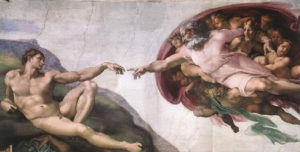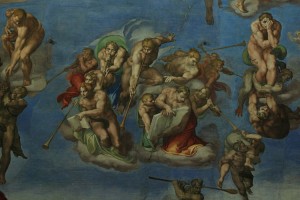The Sistine Chapel, the Cappella Sistina in Italian, is an extraordinary achievement, the main chapel of the Vatican Apostolic Palace, dedicated to the Assumption of Mary.
On the one hand it is one of the most famous artistic works in Rome, marked by the greatest work of Michelangelo Buonarroti, which is discovered on the tour in the Vatican Museums. On the other hand, conclaves are held there with the election of the Pope, and official ceremonies.
It takes its name from Pope Sixtus IV della Rovere, initiator of its construction between 1475 and 1481.
The frescoes of the chapel
The frescoes that decorate its walls are among the most famous works of art in the world. These illustrations form a «Biblia pauperum», perhaps the most important illustration of Judeo-Christian theology.
On the vault Michelangelo painted episodes of the Old Testament (1508-1512): Genesis, Creation of man, Flood, Noah, etc. In the glasses and angles are seen prophets and sibyls and ancestors of Christ. Later, Clement VII Medicis asked the same immense artist to paint on the back wall the Last Judgment (1535-1541). This huge fresco, 20 meters high, represents the glorious return of Christ described by the scriptures. It has a host of characters around Christ and the Virgin who, originally depicted naked, were “dressed” afterwards to hide their intimate anatomy. This “agitated” scene contrasts with the ordinary solemn representations, the characters being very expressive and alive, full of movement.
The other walls are decorated with scenes depicting the Stories of Moses on the south wall and the New Testament on the north side, as well as portraits of Popes. They were painted by great Italian artists of the late 15th century: Sandro Botticelli (episodes of Moses, Temptation of Christ), Pietro Perugino (The Journey of Moses to Egypt, the Baptism of Christ), Pinturicchio, Domenico Ghirlandaio (The Vocation of the First Apostles Peter and Paul), Piero di Cosimo, Cosimo Rosselli (Sermon on the Mount, Last Supper, Tablets of the Law).
In the sixteenth century, the frescoes of the entrance wall were redone: Hendrik van den Broeck painted the Resurrection of Christ of the Guirlandaio, and Matteo da Lecce the Dispute on the body of Moses of Signorelli.
The floor is covered with a beautiful 15th century cosmatesque marble pavement.
Proposals for guided tours and entrance tickets
Informations and links
Timetable
The chapel is usually open Monday to Saturday from 8 a.m. to 7 p.m. (last admission at 5 p.m.).
Closures: on Sundays, as well as in 2024 on 1 and 6 January, 19 March, 1 April, 1 May, 29 June, 14 and 15 August, 1 November, 25 and 26 December.
Links
- One can visits the Chapel inside the Vatican Museums structure
- Sistine Chapel : official website, Wikipedia page
- Website of turismoroma
Map
If you see this after your page is loaded completely, leafletJS files are missing.









